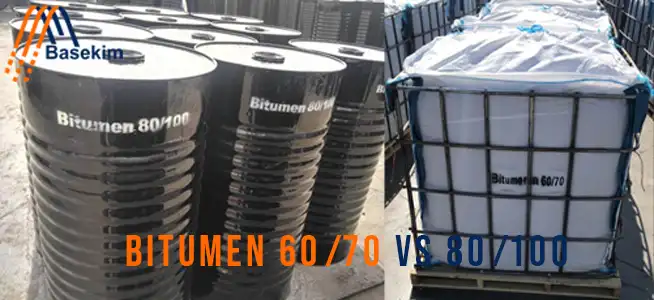Difference Between Bitumen 60/70 vs 80/100: Which Grade to Select?

Introduction:Bitumen 60/70 vs 80/100
When comparing bitumen 60/70 vs 80/100, the primary difference lies in their hardness and performance in different climates. Bitumen 60/70 offers a harder consistency and therefore performs better under heavy traffic and high temperatures. In contrast, bitumen 80/100 remains softer and more flexible, so it works better in colder regions where pavements face contraction and expansion. Because of this, the correct grade depends on climate and road-load conditions. Engineers choose 60/70 for highways in hot areas, while they select 80/100 for medium-traffic roads in moderate or cold locations.
Basekim supplies both penetration grades with internationally certified specifications for asphalt manufacturing and infrastructure development.
Why These Grades Differ in Performance
Although both products belong to the same penetration category, the test results show different ranges. Bitumen 60/70 provides penetration between 60 and 70 dmm, whereas bitumen 80/100 allows penetration between 80 and 100 dmm. Consequently, 60/70 behaves as a harder binder, and 80/100 behaves as a softer one. This variation in stiffness leads to different results in asphalt durability, deformation resistance, workability, and cracking behavior.
What Do the Penetration Grade Numbers Mean?
Penetration bitumen classification depends on the depth a standard needle penetrates the binder at 25°C. The result appears in tenths of a millimeter (dmm). In other words, the penetration value directly represents hardness and binder stiffness. For example:
-
Bitumen 60/70: penetration between 60 and 70 dmm
-
Bitumen 80/100: penetration between 80 and 100 dmm
Because 60/70 shows lower penetration, it provides a harder and more stable structure. Meanwhile, 80/100 contains a softer consistency that improves flexibility in colder climates. Consequently, the number system simplifies grade selection based on environmental and traffic demands.
Bitumen 60/70: Properties and Uses
Bitumen 60/70 has a lower penetration value, so it offers a harder and more stable binder for paving works in warm regions. It resists heavy traffic loads well and maintains shape at high temperatures. Because it has a higher softening point, it prevents rutting and aging issues during long service periods.
Where it works best
-
Highways and industrial roads with intense vehicle pressure
-
Asphalt mixes in hot climates requiring strong deformation control
-
Infrastructure projects where durability and stability remain top priorities
Therefore, road designers rely on bitumen 60/70 for structural performance and minimized maintenance costs in demanding environments.
Bitumen 80/100: Properties and Uses
Bitumen 80/100 contains a softer structure with a higher penetration value, which improves flexibility in colder climates. It absorbs contraction stresses well and supports smooth compaction during asphalt production. Because of this, it prevents thermal cracking and promotes long-term fatigue resistance.
Where it works best
-
Urban and regional roads with moderate traffic
-
Pavements exposed to freeze–thaw cycles
-
Overlay and maintenance projects requiring flexible behavior
Thus, bitumen 80/100 offers reliable pavement performance where climate changes require elasticity rather than maximum hardness.
Bitumen 60/70 vs 80/100: Full Comparison Table
| Feature | Bitumen 60/70 | Bitumen 80/100 |
|---|---|---|
| Hardness | Higher | Lower |
| Flexibility | Lower | Higher |
| Softening Point | Higher | Lower |
| Heat Resistance | Strong | Medium |
| Cold Performance | Medium | Strong |
| Traffic Suitability | Heavy | Medium |
| Best Climate | Hot regions | Cold/moderate regions |
| Rutting Risk | Low | Medium |
| Cracking Risk | Medium | Low |
As the table shows, both grades deliver good performance but under different project conditions. Therefore, understanding the operating environment remains essential before purchasing.
Climate-Based Decision Factors
Temperature affects pavement behavior directly. For example, high temperatures soften asphalt layers. Thus, roads in tropical or desert climates require harder binders like 60/70. Furthermore, heavy trucks increase road surface stress, which leads to rutting if the binder remains soft.
On the other hand, colder countries suffer from contraction and expansion cycles. Consequently, softer grades such as 80/100 perform better because they absorb stress and prevent cracking. Therefore, selecting a grade based on average seasonal temperatures ensures correct pavement functionality.
Traffic-Based Decision Factors
Where traffic volumes remain high, the asphalt layer distributes heavy loads into underlying structures. Because of this, a stiff binder becomes necessary to maintain stability. Bitumen 60/70 supports highways, logistics routes, and loading terminals due to its high structural strength.
Meanwhile, for residential, rural, or urban streets with moderate traffic, bitumen 80/100 offers enough durability with increased resistance to fatigue. Therefore, asphalt designers should always evaluate axle counts and expected traffic growth before finalizing the grade.
Asphalt Mix Design Performance
Binder stiffness and flexibility influence aggregate interlock. As a result, the grade selection changes how the mix behaves.
-
Bitumen 60/70 improves rutting resistance and structural stability. Additionally, it enhances long-term aging resistance.
-
Bitumen 80/100 increases crack resistance, layout flexibility, and compaction efficiency.
Thus, engineers must balance stiffness and elasticity to prevent both rutting and cracking, ensuring asphalt quality over decades.
Quality Control, Standards, and Packaging
International specifications such as ASTM D946 and EN 12591 govern bitumen performance properties. Basekim follows these standards through continuous laboratory testing of penetration, softening point, viscosity, and ductility. Moreover, reliable packaging prevents contamination during transport and storage.
Available packaging options include:
-
New steel drums
-
Poly bags or jumbo bags
-
Bulk tanker and bitutainer delivery
Because supply chain protection influences product quality, certified packaging remains an important purchasing factor.
Final Recommendation
In summary, the correct choice in bitumen 60/70 vs 80/100 depends on environment and expected loading:
Select bitumen 60/70 for:
-
Hot climates and desert regions
-
Roads with heavy axle load
-
Pavements requiring high stability
-
Cold or moderate climates
-
Medium-traffic roads
-
Flexible pavement designs that resist cracking
Therefore, the ideal grade aligns with regional climate and traffic classification rather than cost alone.
Basekim supports clients with accurate grade selection, technical guidance, and consistent supply of both penetration grades to global construction markets.
